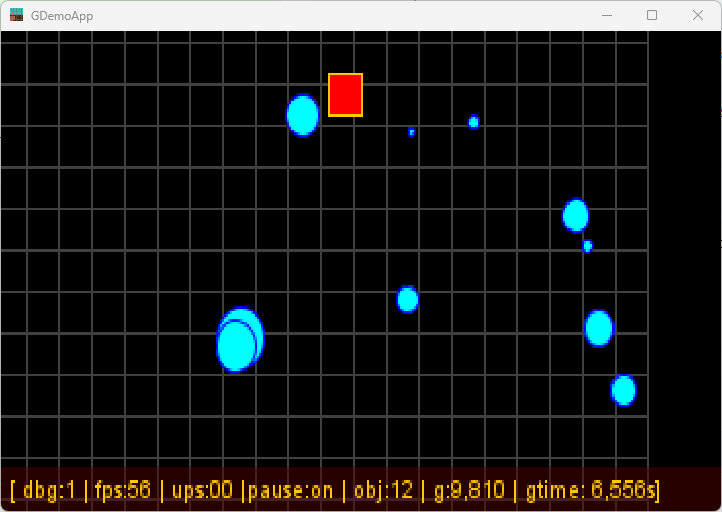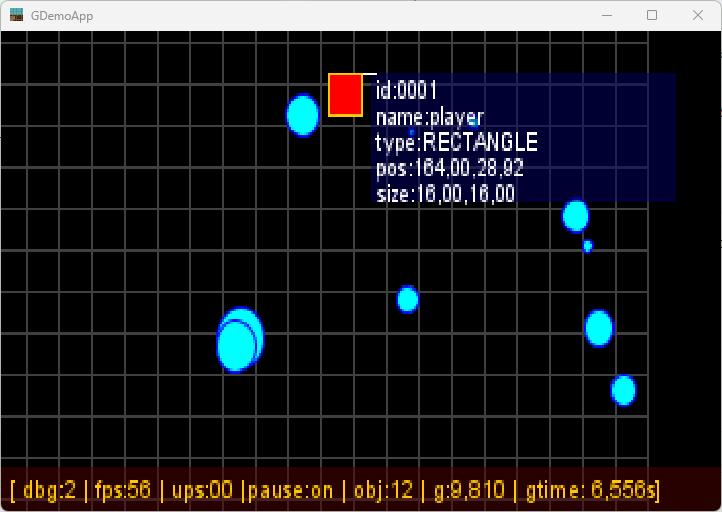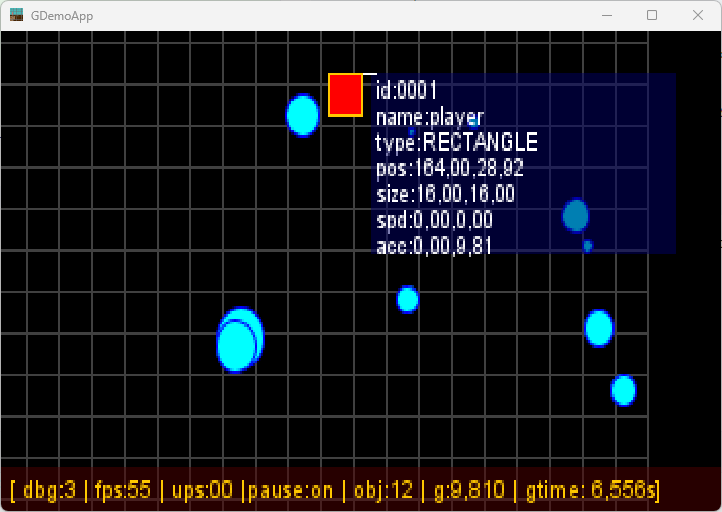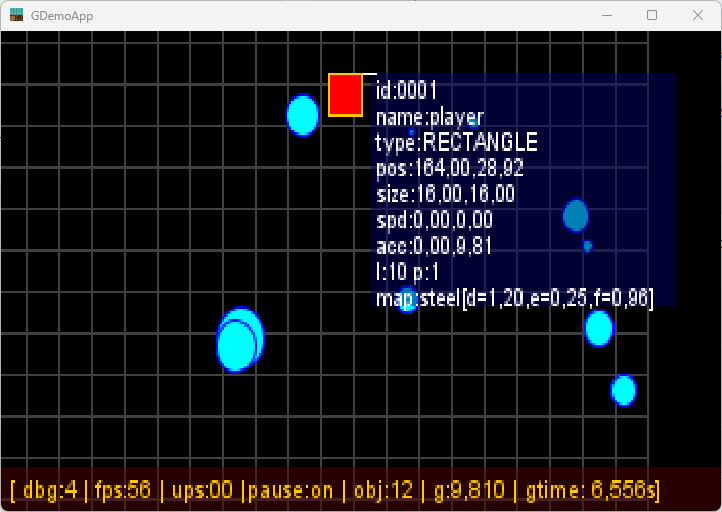game101
Display Debugging information
Goals
The goal of the Display Debug Information layer consists in offering a new way to the developer to see information about some entities. By configuration, the developer will be able to set a level of details, and define on wich entities he wants to get the info.
Rendering debug !
This is possible through the Renderer system, and with some prepared data in the Entity itself.
Adding entity signature
the getDebugInfo() method must provide a list of String containing Entity’s attributes value.
public class Entity<T> {
//...
public List<String> getDebugInfo() {
List<String> infos = new ArrayList<>();
infos.add(String.format("name:%s", name));
infos.add(String.format("pos:%4.2f,%4.2f", x, y));
infos.add(String.format("size:%4.0fx%4.0f", width, height));
infos.add(String.format("spd:%4.2f,%4.2f", dx, dy));
infos.add(String.format("acc:%4.2f,%4.2f", ax, ay));
infos.add(String.format("map:%s[d=%4.2f,e=%4.2f,f=%4.2f]",
material.name,
material.density,
material.elasticity,
material.friction));
return infos;
}
}
Renderer draw !
The Renderer will have the responsibility to draw those data OVER all other layer, and according to level of details for the filtered entities.
The level of detail is defined by the ConfigAttribute.DEBUG_MODE key value, an integer value from 0 to 5.
- 0 means no debug info display,
- 5 maximum debug display details.
The filtering of data is insured by the 2 Configuration keys:
ConfigAttribute.DEBUG_WHILE_LISTthe white list contains the coma separated list of entity’s names you want’s to see debug display info for,ConfigAttribute.DEBUG_BLACK_LISTthe black list contains the list you DON’T to see any debug info for.
Those values are set into the config.properties file like below:
#...
# Debug mode and display information
app.debug.mode=1
app.debug.filter.white.list=player,ball_
app.debug.filter.black.list=
#...
So in the Renderer#draw() method, we need to loop on the entities, when debug mode value is greater than 0.
public class Renderer {
public void draw(Map<String, Object> attributes) {
Graphics2D g = (Graphics2D) buffer.getGraphics();
//...
// draw entity's display debug information
if (game.getDebugMode() > 0) {
game.getEntityManager().getEntities()
.stream()
.sorted((o1, o2) -> o1.getLayer() > o2.getLayer() ? 1 : (o1.getPriority() > o1.getPriority() ? 1 : -1))
.forEach(e -> {
drawDebugInformation(g, e);
});
// draw some debug information.
drawDisplayDebugLine(g, attributes);
}
// release Graphics API
g.dispose();
}
}
And in the drawDebugInformation() method:
TODO explaining and refactor this method that is way more too complex
public class Renderer {
private void drawDebugInformation(Graphics2D g, Entity<?> e) {
if (game.getDebugMode() >= e.debug
&& filterWhiteList.contains(e.name)
&& !filterBlackList.contains(e.name)) {
g.setColor(Color.ORANGE);
g.draw(e.box);
//
if (game.getDebugMode() > 1) {
int offX = (int) e.x + 4;
int offY = (int) e.y;
g.setFont(g.getFont().deriveFont(8.5f));
long nbLines = e.getDebugInfo().stream().filter(s -> game.getDebugMode() >= Integer.parseInt(s.substring(1, 2))).count();
int hh = (int) (g.getFontMetrics().getHeight()
* (nbLines - 1));
if (e.y + hh > buffer.getHeight()) {
offY = buffer.getHeight() - hh;
}
int ww = g.getFontMetrics().stringWidth(e.getDebugInfo().stream().max(Comparator.comparingInt(String::length)).get());
if (e.x + ww > buffer.getWidth()) {
offX = buffer.getWidth() - ww;
}
int l = 0;
for (String s : e.getDebugInfo()) {
if (s.startsWith("(")) {
if (game.getDebugMode() >= Integer.parseInt(s.substring(1, 2))) {
l += 10;
g.setColor(new Color(0.0f, 0.0f, 0.4f, 0.5f));
g.fillRect((int) (offX + e.width + 1), offY - 10 + l, ww + 2, 10);
g.setColor(Color.WHITE);
g.drawString(s.substring(3), (int) (offX + e.width + 4), offY + l);
}
} else {
l += 10;
g.drawString(s, (int) (offX + e.width + 4), offY + l);
}
}
g.drawLine((int) (e.x + e.width + 1.0), (int) e.y, (int) (offX + e.width + 3.0), offY);
}
}
}
}
This is now displaying the following information with debug mode level 2 to 5:




Conclusion
According to our last development and changes, we are now able to display some valuable display debug information.
The corresponding code will be found on GitHub project Game101.
THs specific add wil lbe linked by tha tag create-debug-info.
That’s all Folk !
McG.